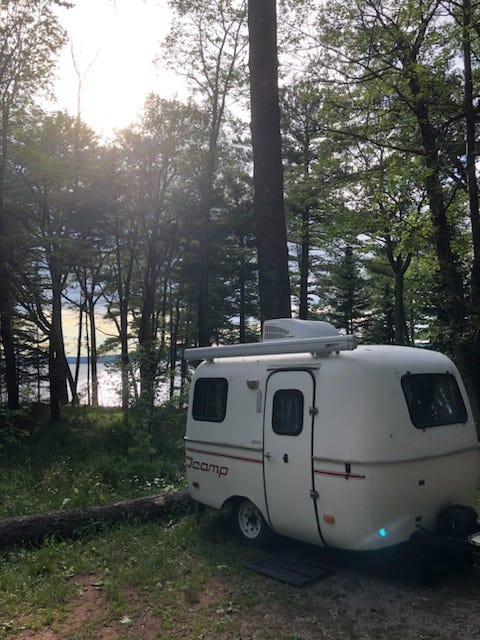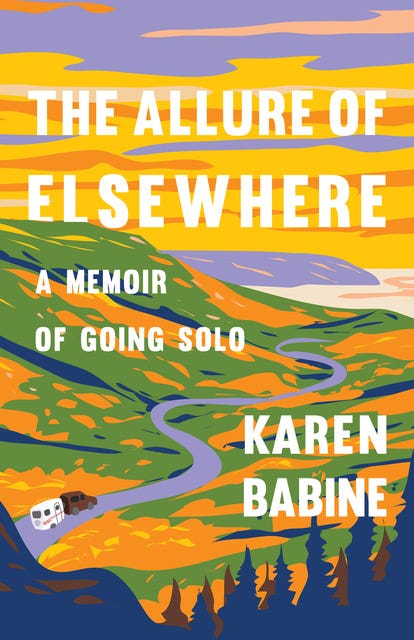I don’t typically review books on my Substack, but I decided to make an exception with this one.
The Allure of Elsewhere: A Memoir of Going Solo by Karen Babine (Milkweed Press) https://milkweed.org/book/the-allure-of-elsewhere.
I have long believed that we carry stories in our bodies, just as the landscape writes its stories into its bedrock, and these stories are no less present for lacking human speech.
Karen Babine’s new travel memoir, The Allure of Elsewhere, follows the author’s trek from Minnesota to Canada’s Maritimes with her trusty Scamp trailer in tow and her two companionable felines. At once, a celebration of a capable and confident woman traveling solo and an investigation into her family’s roots, Babine fills in the inevitable gaps and silences of generations past with speculation and wonderment. It’s a book about arriving and never arriving, as long as the family line persists.
As family historian, Babine’s (pronounced “Bay-Byne”) job is not an easy one. Like her, I’m my family’s historian, at least for my immediate family, and as anyone in this position soon realizes, most families don’t really want their true histories told. Family trees are harmless because they don’t spill shameful secrets for the most part. Families, like nations, want to present to the world a picture of health, happiness, and accomplishment.
But generational silences haunt family historians like Babine. A central haunting story is the murder of her great grandmother and great uncle by the troubled nephew of her grandfather, a story she stumbled upon by chance when she was seventeen. She had just sketched a family tree, and showing it to her father, she wondered aloud why his grandmother Catherine and his Uncle Walt had the same death date. She hadn’t expected the answer to be murder. And this wasn’t the only tragedy in that immediate family. Her grandfather’s father, a traumatized veteran of World War One, had killed himself after receiving a draft notice during World War Two. Not surprisingly, her grandfather, the survivor of all this tragedy, had no intention of passing on the family history and recycled the same three innocuous and pleasant anecdotes whenever young Karen or anyone else wanted to know about his life.
It’s her need to know the unknowable that compels Babine to take the central journey that forms the spine of this book. The Expulsion of the French Acadians in the Maritimes of what is now Canada by the British between 1755 and 1764, (Le Grand Derangement) saw many of Babine’s ancestors caught up in this early example of ethnic cleaning. During this period of the war between the French and the British, thousands of French civilians were rounded up and placed on ships heading anywhere and everywhere. A little under half of those deported died from hunger, disease, and shipwrecks. Some of Babine’s ancestors were imprisoned and deported, and so there’s an aspect of pilgrimage to this book as she travels eastward to the places they settled, were thrust out of, and settled again.
These are her roots, not ours, and while we might be less interested in wading through the weeds of Ancestry.com of the Babine clan, her central question is pertinent to us all: Who are we in relation to our relations?
“I have long believed that we carry stories in our bodies,” she writes, “just as the landscape writes its stories into its bedrock, and these stories are no less present for lacking human speech.”
I believe this, too, just as I believe that landscapes contain stories, whether those stories can be told or not. The Cathar region of France, where thousands were murdered on orders of the Pope, is one such landscape haunted by its untold stories. The Australian island of Tasmania is another, haunted by the genocide of its aboriginal people, who were hunted down mercilessly to the very last person. Visit either and you will feel those stories under your skin. In Babine’s case, she finds a landscape’s story on Grosse Ile, an island in the St. Lawrence River in Quebec, where five thousand four hundred and twenty-four Irish immigrants perished (as well as others, though the majority were Irish) in the summer of 1847 of disease, while waiting to be admitted to Canada. While “this history does not belong to [her] blood,” the landscape taught her how to listen to its stories. The vast meadow graveyard where nearly all the Irish are buried, the size of a football field, undulates with waves of mounds and troughs. Babine at first assumes that the rises in the land are the grave sites. In fact, the opposite is true. The men, women, and children were buried in simple coffins in layers, and as their bodies and the coffins decomposed, the land collapsed underneath them. Later, in an Acadian cemetery where she knows her ancestors are buried, she reads the landscape and absorbs its story, a story of attempted erasure. She will never be able to locate the exact gravesites of those who came before her because the Acadians marked their graves with simple white crosses, not stone, and those have long since vanished.
But I would be mischaracterizing this book to suggest that it is solely about such sad histories. The book is as much a celebration as it is elegy. It’s also an homage to her father, who taught her everything she needed to know about self-sufficiency, self-confidence, and how to fix or build just about anything. With her custom self-designed Scamp, Babine encounters plenty of patronizing men who offer to help her when she doesn’t need any help and could almost certainly teach them a thing or two, but she shrugs them off and continues (merrily, for the most part) on her way.






Hi Robin! This book sounds fascinating!
Thank you for writing this review of Karen Babine's book. As the author of MAKING OLIVES AND OTHER FAMILY SECRETS (Ripasso edition) (Longbridge Books), the issue of consequences to delving into secrets within the family resonated with me personally. I've put the book on my list! Darlene Madott